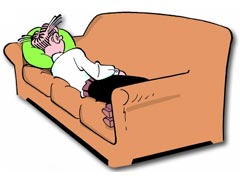 This won't come as a surprise to anyone who's ever held their breath during a heavy squat, but a study published in September's Archives of Ophthalmology indicates that performing the Valsalva maneuver increases intraocular pressure (the pressure within the eyeballs).
This won't come as a surprise to anyone who's ever held their breath during a heavy squat, but a study published in September's Archives of Ophthalmology indicates that performing the Valsalva maneuver increases intraocular pressure (the pressure within the eyeballs).
The downside of this long-term is that there is a slightly increased risk of getting normal-tension glaucoma, which is a little more common in people who've experienced frequent pressure changes in their eyes. I suspect bungee-jumping instructors are at the top of the 'most likely' list.
 This won't come as a surprise to anyone who's ever held their breath during a heavy squat, but
This won't come as a surprise to anyone who's ever held their breath during a heavy squat, but  Or 'The spear, the shield and the crazy monkey'.
Or 'The spear, the shield and the crazy monkey'. I've been interested in
I've been interested in  I've been interested in
I've been interested in 
 The other day I came across
The other day I came across  Noticed this over on
Noticed this over on  Noticed this over on
Noticed this over on 